Redis之sql缓存的具体使用
本文主要介绍了Redis之sql缓存的具体使用,文中通过示例代码介绍的非常详细,具有一定的参考价值,感兴趣的小伙伴们可以参考一下
目录
1.环境搭建
2.Redis配置
3.功能实现
4.缓存注解的使用说明
1.环境搭建
1 2 3 4 5 | <!-- RedisTemplate --><dependency> <groupId>org.springframework.boot</groupId> <artifactId>spring-boot-starter-data-redis</artifactId></dependency> |
1 2 3 4 5 6 7 8 9 10 11 12 13 | spring: redis: host: 192.168.8.128 port: 6380 password: 1234 database: 0 timeout: 3000 jedis: pool: max-wait: -1 max-active: -1 max-idle: 20 min-idle: 10 |
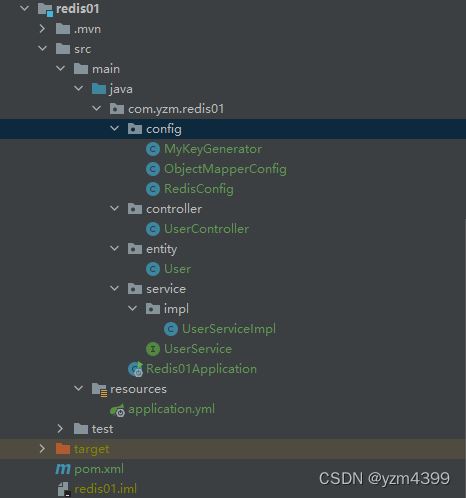
2.Redis配置
1 2 3 4 5 6 7 8 9 10 11 12 13 14 15 16 17 18 19 20 21 22 23 24 25 26 27 28 29 30 31 32 33 34 35 36 37 38 39 40 41 42 43 44 45 46 47 48 49 50 51 52 53 54 55 56 57 58 59 60 61 62 63 64 65 66 | package com.yzm.redis01.config;import com.fasterxml.jackson.annotation.JsonAutoDetect;import com.fasterxml.jackson.annotation.JsonInclude;import com.fasterxml.jackson.annotation.JsonTypeInfo;import com.fasterxml.jackson.annotation.PropertyAccessor;import com.fasterxml.jackson.core.JsonGenerator;import com.fasterxml.jackson.core.JsonParser;import com.fasterxml.jackson.databind.*;import com.fasterxml.jackson.datatype.jsr310.JavaTimeModule;import org.springframework.context.annotation.Bean;import org.springframework.context.annotation.Configuration;import java.io.IOException;import java.text.SimpleDateFormat;import java.time.LocalDateTime;import java.time.format.DateTimeFormatter;@Configurationpublic class ObjectMapperConfig { private static final String PATTERN = "yyyy-MM-dd HH:mm:ss"; @Bean(name = "myObjectMapper") public ObjectMapper objectMapper() { JavaTimeModule javaTimeModule = new JavaTimeModule(); javaTimeModule.addSerializer(LocalDateTime.class, new LocalDateTimeSerializer()); javaTimeModule.addDeserializer(LocalDateTime.class, new LocalDateTimeDeserializer()); return new ObjectMapper() // 转换为格式化的json(控制台打印时,自动格式化规范) //.enable(SerializationFeature.INDENT_OUTPUT) // Include.ALWAYS 是序列化对像所有属性(默认) // Include.NON_NULL 只有不为null的字段才被序列化,属性为NULL 不序列化 // Include.NON_EMPTY 如果为null或者 空字符串和空集合都不会被序列化 // Include.NON_DEFAULT 属性为默认值不序列化 .setSerializationInclusion(JsonInclude.Include.NON_NULL) // 如果是空对象的时候,不抛异常 .configure(SerializationFeature.FAIL_ON_EMPTY_BEANS, false) // 反序列化的时候如果多了其他属性,不抛出异常 .configure(DeserializationFeature.FAIL_ON_UNKNOWN_PROPERTIES, false) // 取消时间的转化格式,默认是时间戳,可以取消,同时需要设置要表现的时间格式 .configure(SerializationFeature.WRITE_DATES_AS_TIMESTAMPS, false) .setDateFormat(new SimpleDateFormat(PATTERN)) // 对LocalDateTime序列化跟反序列化 .registerModule(javaTimeModule) .setVisibility(PropertyAccessor.ALL, JsonAutoDetect.Visibility.ANY) // 此项必须配置,否则会报java.lang.ClassCastException: java.util.LinkedHashMap cannot be cast to XXX .enableDefaultTyping(ObjectMapper.DefaultTyping.NON_FINAL, JsonTypeInfo.As.PROPERTY) ; } static class LocalDateTimeSerializer extends JsonSerializer<LocalDateTime> { @Override public void serialize(LocalDateTime value, JsonGenerator gen, SerializerProvider serializers) throws IOException { gen.writeString(value.format(DateTimeFormatter.ofPattern(PATTERN))); } } static class LocalDateTimeDeserializer extends JsonDeserializer<LocalDateTime> { @Override public LocalDateTime deserialize(JsonParser p, DeserializationContext deserializationContext) throws IOException { return LocalDateTime.parse(p.getValueAsString(), DateTimeFormatter.ofPattern(PATTERN)); } }} |
1 2 3 4 5 6 7 8 9 10 11 12 13 14 15 16 17 18 19 20 21 22 23 24 25 26 27 28 29 | package com.yzm.redis01.config;import lombok.extern.slf4j.Slf4j;import org.springframework.cache.interceptor.KeyGenerator;import org.springframework.cache.interceptor.SimpleKey;import java.lang.reflect.Method;import java.util.Arrays;/** * key生成器 */@Slf4jpublic class MyKeyGenerator implements KeyGenerator { private static final String NO_PARAM = "[]"; private static final String NULL_PARAM = "_"; @Override public Object generate(Object target, Method method, Object... params) { StringBuilder key = new StringBuilder(); key.append(target.getClass().getSimpleName()).append(".").append(method.getName()).append(":"); if (params.length == 0) { return new SimpleKey(key.append(NO_PARAM).toString()); } return new SimpleKey(key.append(Arrays.toString(params).replace("null", NULL_PARAM)).toString()); }} |
1 2 3 4 5 6 7 8 9 10 11 12 13 14 15 16 17 18 19 20 21 22 23 24 25 26 27 28 29 30 31 32 33 34 35 36 37 38 39 40 41 42 43 44 45 46 47 48 49 50 51 52 53 54 55 56 57 58 59 60 61 62 63 64 65 66 67 68 69 70 71 72 73 74 75 76 77 78 79 80 81 82 83 | package com.yzm.redis01.config;import com.fasterxml.jackson.databind.ObjectMapper;import org.springframework.cache.CacheManager;import org.springframework.cache.annotation.EnableCaching;import org.springframework.context.annotation.Bean;import org.springframework.context.annotation.Configuration;import org.springframework.data.redis.cache.RedisCacheConfiguration;import org.springframework.data.redis.cache.RedisCacheManager;import org.springframework.data.redis.cache.RedisCacheWriter;import org.springframework.data.redis.connection.RedisConnectionFactory;import org.springframework.data.redis.core.*;import org.springframework.data.redis.serializer.Jackson2JsonRedisSerializer;import org.springframework.data.redis.serializer.RedisSerializationContext;import org.springframework.data.redis.serializer.StringRedisSerializer;import javax.annotation.Resource;import java.time.Duration;@Configuration@EnableCaching // 启动缓存public class RedisConfig { @Bean(name = "myKeyGenerator") public MyKeyGenerator myKeyGenerator() { return new MyKeyGenerator(); } @Resource(name = "myObjectMapper") private ObjectMapper objectMapper; /** * 选择redis作为默认缓存工具 */ @Bean public CacheManager cacheManager(RedisConnectionFactory connectionFactory) { RedisCacheWriter redisCacheWriter = RedisCacheWriter.nonLockingRedisCacheWriter(connectionFactory); RedisCacheConfiguration cacheConfiguration = RedisCacheConfiguration .defaultCacheConfig() // 默认缓存时间(秒) .entryTtl(Duration.ofSeconds(300L)) // 序列化key、value .serializeKeysWith(RedisSerializationContext.SerializationPair.fromSerializer(new StringRedisSerializer())) .serializeValuesWith(RedisSerializationContext.SerializationPair.fromSerializer(jackson2JsonRedisSerializer())) // 禁用缓存空值 .disableCachingNullValues(); return new RedisCacheManager(redisCacheWriter, cacheConfiguration); } /** * redisTemplate配置 */ @Bean public RedisTemplate<String, Object> redisTemplate(RedisConnectionFactory factory) { RedisTemplate<String, Object> template = new RedisTemplate<>(); // 配置连接工厂 template.setConnectionFactory(factory); Jackson2JsonRedisSerializer<Object> jacksonSerializer = jackson2JsonRedisSerializer(); StringRedisSerializer stringRedisSerializer = new StringRedisSerializer(); // 使用StringRedisSerializer来序列化和反序列化redis的key,value采用json序列化 template.setKeySerializer(stringRedisSerializer); template.setValueSerializer(jacksonSerializer); // 设置hash key 和value序列化模式 template.setHashKeySerializer(stringRedisSerializer); template.setHashValueSerializer(jacksonSerializer); //支持事务 template.setEnableTransactionSupport(true); template.afterPropertiesSet(); return template; } private Jackson2JsonRedisSerializer<Object> jackson2JsonRedisSerializer() { //使用Jackson2JsonRedisSerializer来序列化和反序列化redis的value值(默认使用JDK的序列化方式) Jackson2JsonRedisSerializer<Object> jacksonSerializer = new Jackson2JsonRedisSerializer<>(Object.class); jacksonSerializer.setObjectMapper(objectMapper); return jacksonSerializer; }} |
3.功能实现
新增、更新、删除、查询数据时,对缓存执行对应相同的操作
1 2 3 4 5 6 7 8 9 10 11 12 13 14 15 16 17 18 19 20 21 22 23 24 25 | package com.yzm.redis01.entity;import lombok.AllArgsConstructor;import lombok.Builder;import lombok.Data;import lombok.NoArgsConstructor;import lombok.experimental.Accessors;import java.io.Serializable;import java.time.LocalDateTime;import java.util.Date;@Data@Builder@NoArgsConstructor@AllArgsConstructor@Accessors(chain = true)public class User implements Serializable { private static final long serialVersionUID = -2468903864827432779L; private Integer id; private String username; private String password; private Date createDate; private LocalDateTime updateDate;} |
1 2 3 4 5 6 7 8 9 10 11 12 13 14 15 16 17 18 19 20 21 22 | package com.yzm.redis01.service;import com.yzm.redis01.entity.User;import java.util.List;public interface UserService { User saveUser(User user); User updateUser(User user); int deleteUser(Integer id); void deleteAllCache(); User getUserById(Integer id); List<User> selectAll(); List<User> findAll(Object... params);} |
为了简便,数据不从数据库获取,这里是创建Map存储数据实现
1 2 3 4 5 6 7 8 9 10 11 12 13 14 15 16 17 18 19 20 21 22 23 24 25 26 27 28 29 30 31 32 33 34 35 36 37 38 39 40 41 42 43 44 45 46 47 48 49 50 51 52 53 54 55 56 57 58 59 60 61 62 63 64 65 66 67 68 69 70 71 72 73 74 75 76 77 78 79 80 81 82 83 84 85 86 87 88 89 90 91 92 93 94 95 96 97 98 99 100 | package com.yzm.redis01.service.impl;import com.yzm.redis01.entity.User;import com.yzm.redis01.service.UserService;import lombok.extern.slf4j.Slf4j;import org.springframework.cache.annotation.CacheConfig;import org.springframework.cache.annotation.CacheEvict;import org.springframework.cache.annotation.CachePut;import org.springframework.cache.annotation.Cacheable;import org.springframework.stereotype.Service;import java.time.LocalDateTime;import java.util.*;@Slf4j@Service@CacheConfig(cacheNames = "users")public class UserServiceImpl implements UserService { private static final Map<Integer, User> userMap; static { userMap = new HashMap<>(); userMap.put(userMap.size() + 1, User.builder() .id(userMap.size() + 1).username("root").password("root").createDate(new Date()).updateDate(LocalDateTime.now()).build()); userMap.put(userMap.size() + 1, User.builder() .id(userMap.size() + 1).username("admin").password("admin").createDate(new Date()).updateDate(LocalDateTime.now()).build()); } @Override @CachePut(key = "#result.id", condition = "#result.id gt 0") public User saveUser(User user) { log.info("保存数据"); int id = userMap.size() + 1; User build = User.builder() .id(id) .username(user.getUsername()) .password(user.getPassword()) .createDate(new Date()) .updateDate(LocalDateTime.now()) .build(); userMap.put(id, build); return build; } @Override @CachePut(key = "#user.id", unless = "#result eq null") public User updateUser(User user) { log.info("更新数据"); if (userMap.containsKey(user.getId())) { User update = userMap.get(user.getId()); update.setUsername(user.getUsername()) .setPassword(user.getPassword()) .setUpdateDate(LocalDateTime.now()); userMap.replace(user.getId(), update); return update; } return null; } @Override @CacheEvict(key = "#id", condition = "#result gt 0") public int deleteUser(Integer id) { log.info("删除数据"); if (userMap.containsKey(id)) { userMap.remove(id); return 1; } return 0; } @Override @CacheEvict(allEntries = true) public void deleteAllCache() { log.info("清空缓存"); } @Override @Cacheable(key = "#id", condition = "#id gt 1") public User getUserById(Integer id) { log.info("查询用户"); return userMap.get(id); } @Override @Cacheable(key = "#root.methodName") public List<User> selectAll() { log.info("查询所有"); return new ArrayList<>(userMap.values()); } @Override @Cacheable(keyGenerator = "myKeyGenerator") public List<User> findAll(Object... params) { log.info("查询所有"); return new ArrayList<>(userMap.values()); }} |
1 2 3 4 5 6 7 8 9 10 11 12 13 14 15 16 17 18 19 20 21 22 23 24 25 26 27 28 29 30 31 32 33 34 35 36 37 38 39 40 41 42 43 44 45 46 47 48 49 50 51 52 53 54 55 56 57 58 59 | package com.yzm.redis01.controller;import com.yzm.redis01.entity.User;import com.yzm.redis01.service.UserService;import org.springframework.web.bind.annotation.GetMapping;import org.springframework.web.bind.annotation.RequestMapping;import org.springframework.web.bind.annotation.RequestParam;import org.springframework.web.bind.annotation.RestController;import java.util.List;@RestController@RequestMapping("/user")public class UserController { private final UserService userService; public UserController(UserService userService) { this.userService = userService; } @GetMapping("/saveUser") public void saveUser() { User user = new User(); user.setUsername("yzm"); user.setPassword("yzm"); System.out.println(userService.saveUser(user)); } @GetMapping("/updateUser") public void updateUser(Integer id) { User user = new User(); user.setId(id); user.setUsername("yzm"); user.setPassword("123"); System.out.println(userService.updateUser(user)); } @GetMapping("/deleteUser") public void deleteUser(@RequestParam Integer id) { System.out.println(userService.deleteUser(id)); } @GetMapping("/deleteAllCache") public void deleteAllCache() { userService.deleteAllCache(); } @GetMapping("/getUserById") public void getUserById(@RequestParam Integer id) { System.out.println(userService.getUserById(id)); } @GetMapping("/selectAll") public void selectAll() { List<User> users = userService.selectAll(); users.forEach(System.out::println); }} |
4.缓存注解的使用说明
@CacheConfig:注解在类上,表示该类所有缓存方法使用统一指定的缓存区,也可以作用在方法上

@CacheAble:注解在方法上,应用到读数据的方法上,如查找方法:调用方法之前根据条件判断是否从缓存获取相应的数据,缓存没有数据,方法执行后添加到缓存
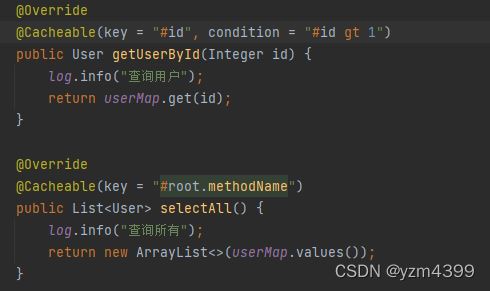
#id 直接使用参数名
#p0 p0对应参数列表的第一个参数,以此类推
#user.id 参数是对象时,使用对象属性
#root. 可以点出很多方法
#root.methodName
#result 返回值
http://localhost:8080/user/getUserById?id=1

http://localhost:8080/user/getUserById?id=2

http://localhost:8080/user/selectAll

@Cacheable运行流程:在调用方法之前判断condition,如果为true,则查缓存;没有缓存就调用方法并将数据添加到缓存;condition=false就与缓存无关了
@CachePut:注解在方法上,应用到写数据的方法上,如新增/修改方法,调用方法之后根据条件判断是否添加/更新相应的数据到缓存:
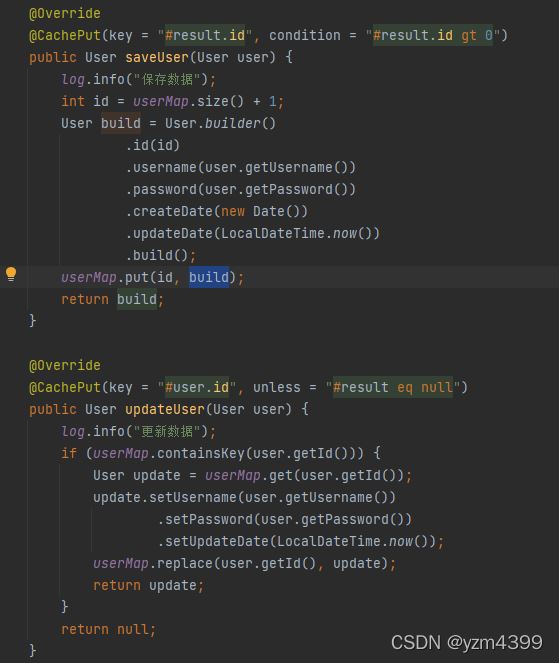
http://localhost:8080/user/saveUser

condition条件为true,添加到缓存,根据id查询直接从缓存获取
http://localhost:8080/user/getUserById?id=3

http://localhost:8080/user/updateUser?id=3
http://localhost:8080/user/getUserById?id=3
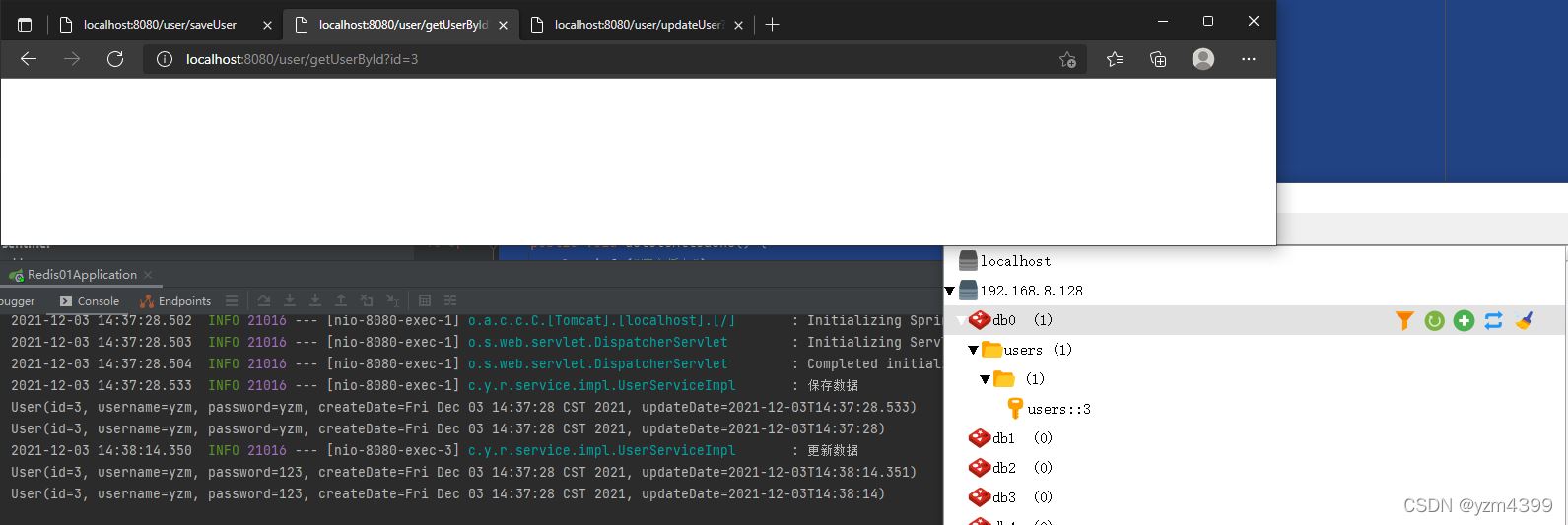
条件condition=true,执行缓存操作
条件unless=false,执行缓存操作;跟condition相反
@CacheEvict 注解在方法上,应用到删除数据的方法上,如删除方法,调用方法之后根据条件判断是否从缓存中移除相应的数据
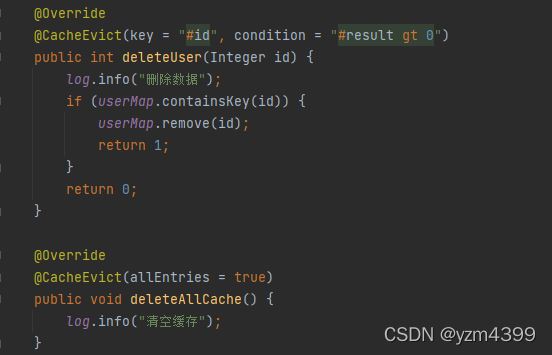
http://localhost:8080/user/saveUser
http://localhost:8080/user/getUserById?id=3
http://localhost:8080/user/deleteUser?id=3

自定义缓存key自动生成器
1 2 3 4 5 6 | @Override@Cacheable(keyGenerator = "myKeyGenerator")public List<User> findAll(Object... params) { log.info("查询所有"); return new ArrayList<>(userMap.values());} |
1 2 3 4 5 6 7 8 9 10 11 12 13 14 15 16 17 18 | @Slf4jpublic class MyKeyGenerator implements KeyGenerator { private static final String NO_PARAM = "[]"; private static final String NULL_PARAM = "_"; @Override public Object generate(Object target, Method method, Object... params) { StringBuilder key = new StringBuilder(); key.append(target.getClass().getSimpleName()).append(".").append(method.getName()).append(":"); if (params.length == 0) { return new SimpleKey(key.append(NO_PARAM).toString()); } return new SimpleKey(key.append(Arrays.toString(params).replace("null", NULL_PARAM)).toString()); }} |
http://localhost:8080/user/findAll

http://localhost:8080/user/findAll?id=123

http://localhost:8080/user/findAll?username=yzm

@Caching
有时候我们可能组合多个Cache注解使用;比如用户新增成功后,我们要添加id–>user;username—>user;email—>user的缓存;
此时就需要@Caching组合多个注解标签了。
1 2 3 4 5 6 7 8 | @Caching( put = { @CachePut(value = "users", key = "#user.id"), @CachePut(value = "users", key = "#user.username"), @CachePut(value = "users", key = "#user.email") })public User save(User user) {} |
到此这篇关于Redis之sql缓存的具体使用的文章就介绍到这了
原文链接:https://blog.csdn.net/qq_43654581/article/details/121677623

